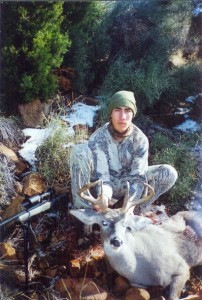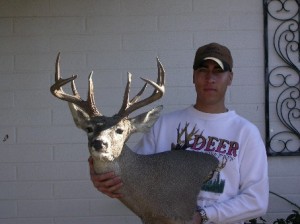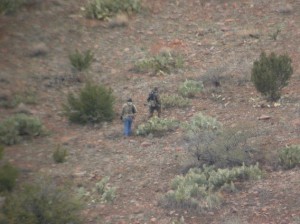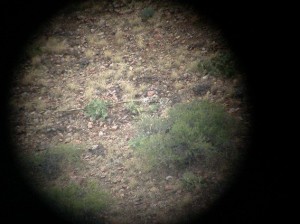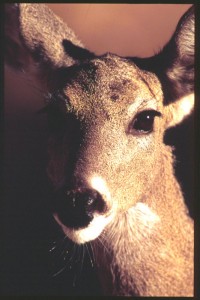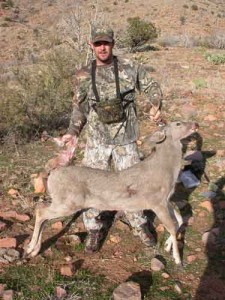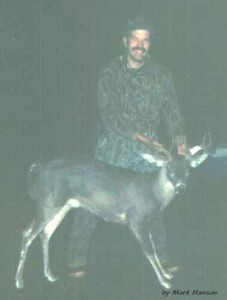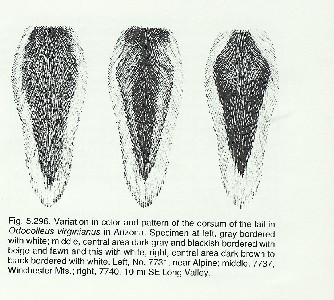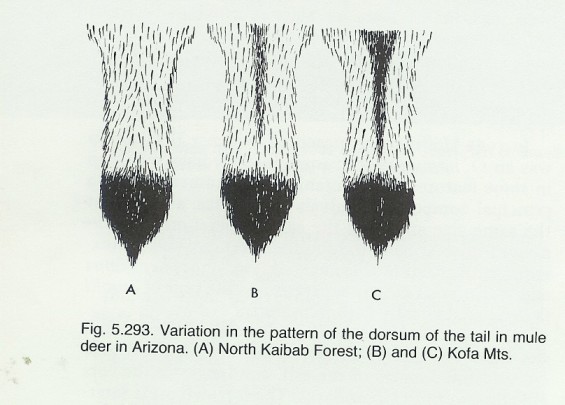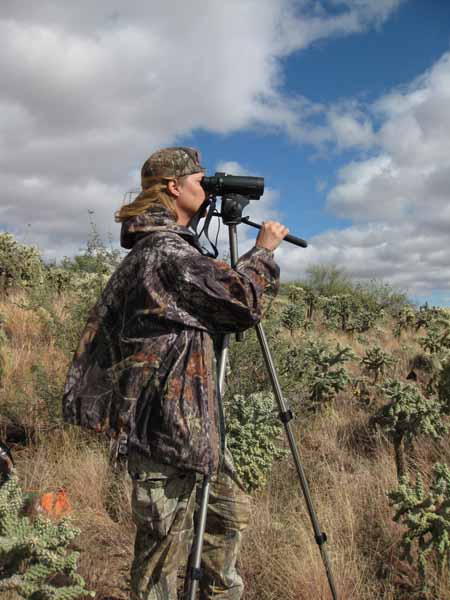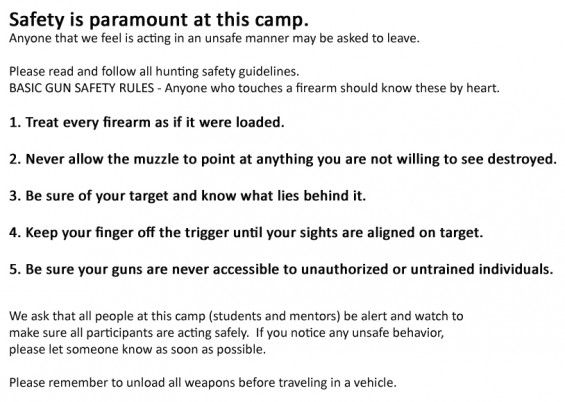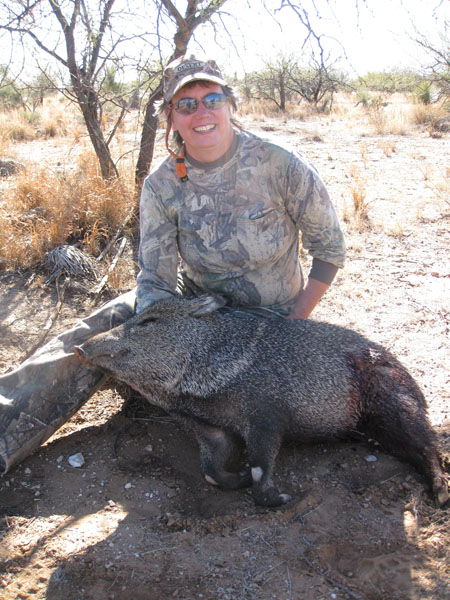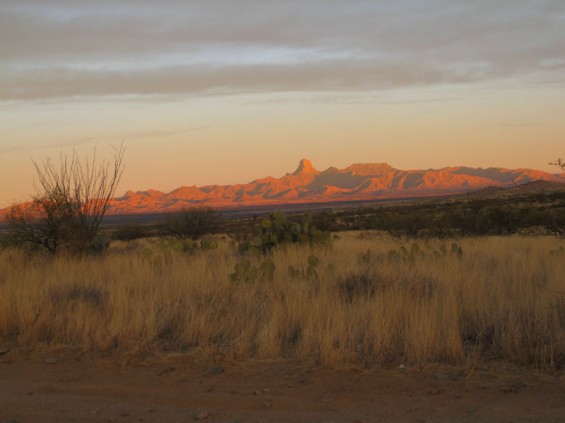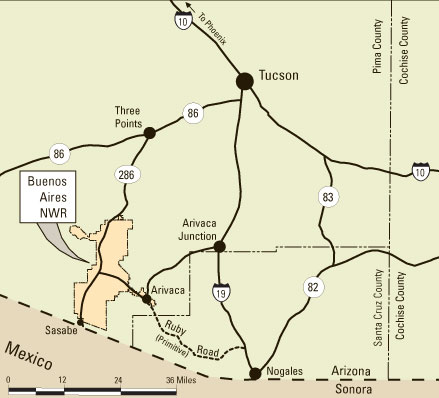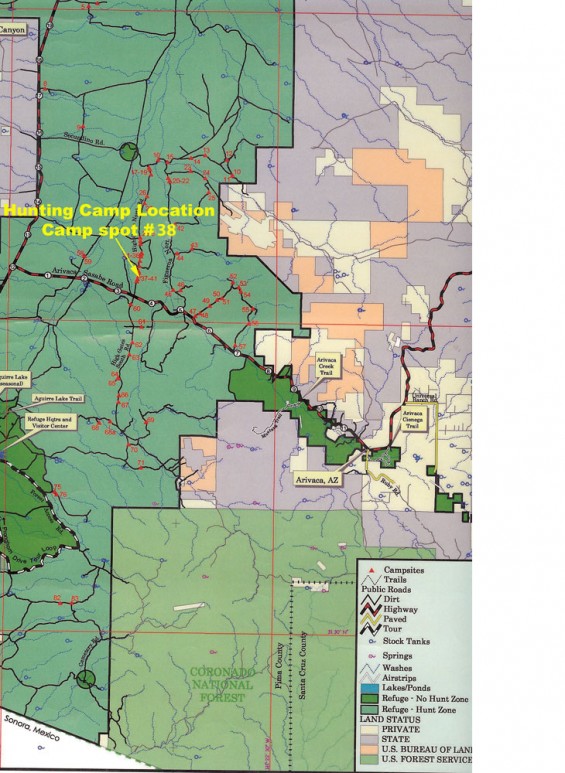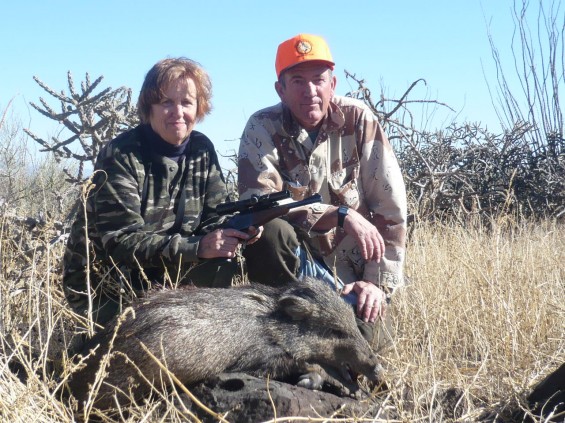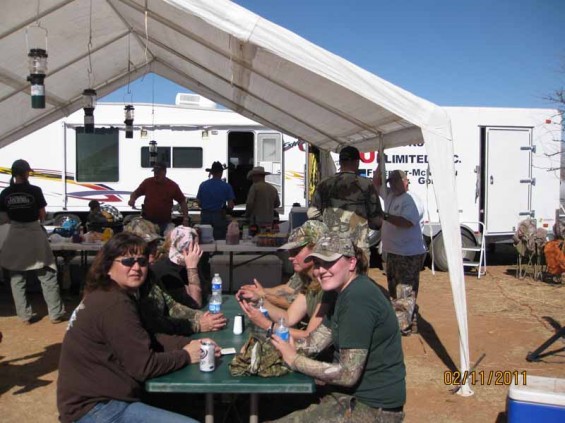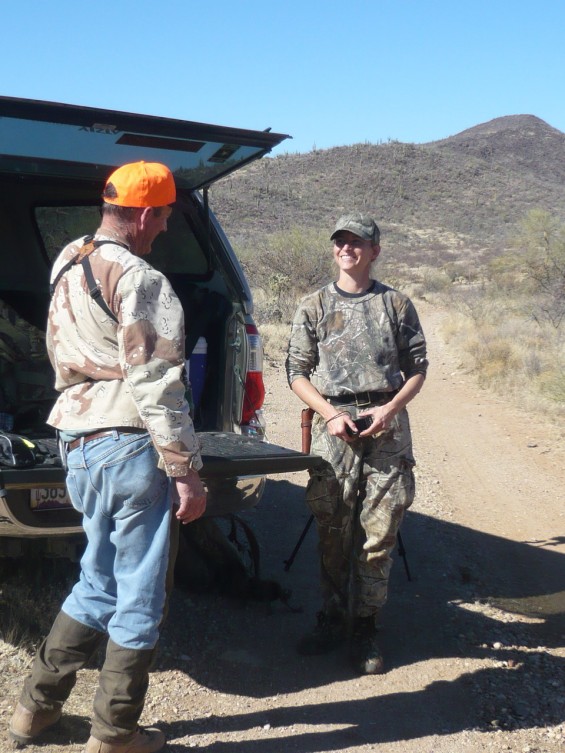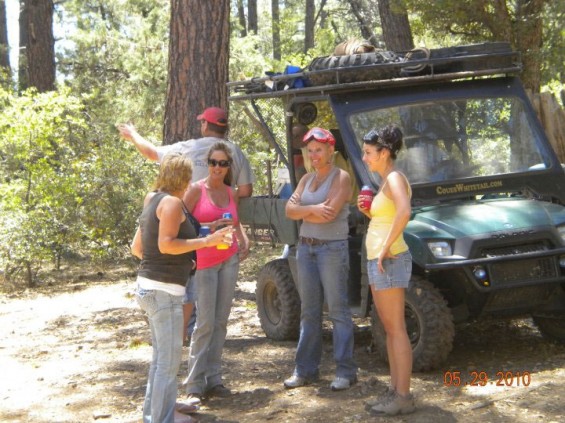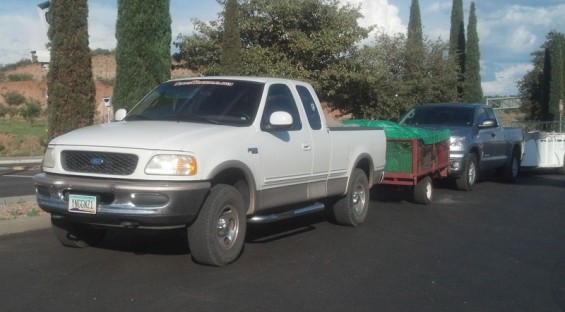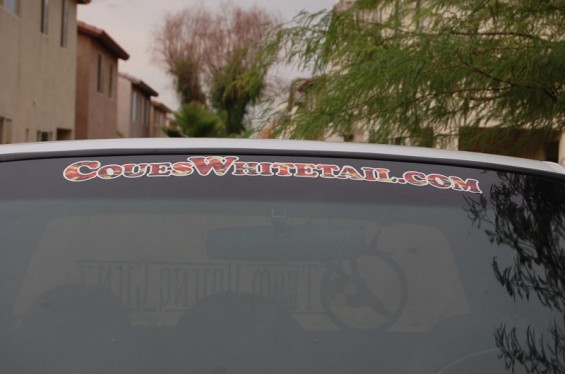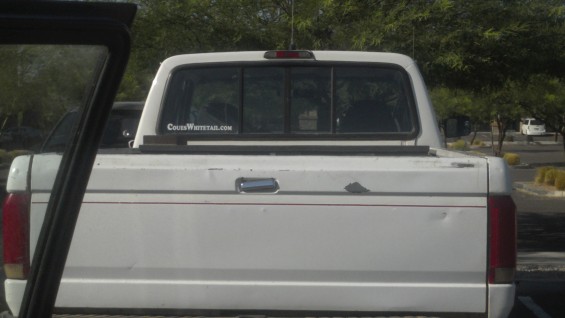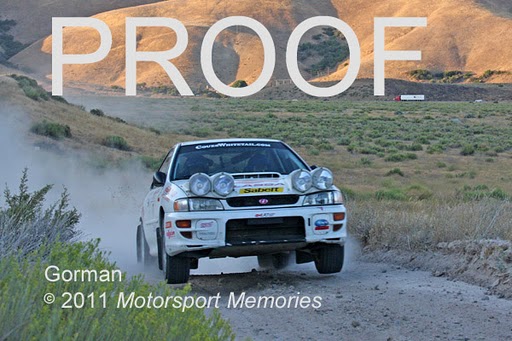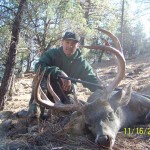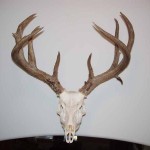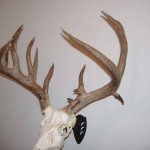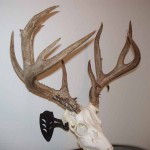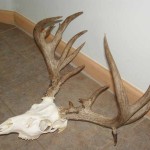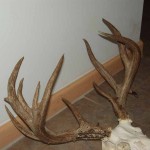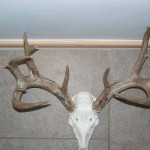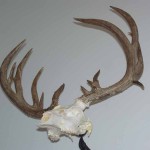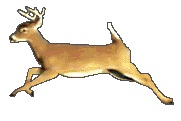Posts
Hunting Strategies
Weapon caliber
The Coues deer is a small whitetail (a good buck might only weigh 80-90 lbs.), for which small caliber weapons can be appropriate. I use a .270 to hunt for Coues, but you could even go with a smaller caliber weapon like a .22-.250 or .243. Many people use 7mm mags. What you want is a very flat shooting rifle that will allow you to become proficient at long-range shooting (250-400 yards).
As many guides will tell you, they want clients that are able to shot long distances because the bucks they spot may be far across a canyon. And quietly stalking to that far side of the canyon may be impossible due to the rocky soil and thick brush that is found in Coues country. Shot placement is very important to making a clean kill. Click on the “Shot Placement” button on the left to learn more about a well-placed shot.
Spot and Stalk
Most people who hunt Coues use the “Spot and Stalk” method. This method is ideal for our open landscapes in the West. To effectively spot Coues whitetail you will want to have premium optics. For years I hunted with cheap 7×35 binoculars, and although I was successful, I recommend that you buy the best binoculars (glass) you can afford. Several years ago, I upgraded to Zeiss 10×40’s which have made spotting deer much easier. Some people prefer to go with even more powerful binoculars, such as 15×60. That magnification is outstanding for spotting pieces of deer through foliage. But they are heavy to carry and most Coues hunters opt not to carry such large optics. The best binoculars and spotting scopes are made by Zeiss, Leica, and Swarovski. These high-end optics are superior in the light-gathering and contrasting ability. In low light situations, I can see deer in my binoculars when I can’t see them with my naked eye – it’s as if the binoculars turn on some extra lights. If you are looking to buy some new optics, please check one of our sponsors, Camera Land. They carry an excellent variety of binoculars and spotting scopes.
To use the “Spot and Stalk” method, find a high point in some good Coues habitat, sit down and use your binoculars to search the terrain for deer. The key to finding Coues is to GLASS, GLASS, GLASS. Several times I have been out hunting somewhere and seen some hunters drive up, jump out and quickly scan a canyon with binoculars. After about 10 minutes of searching, they are convinced that there are no bucks and they leave. Meanwhile, because I have been there glassing longer, I have found deer in that canyon that they missed. The old rule of thumb of that you should “wear the seat of your pants out before your boots” is very applicable to Coues hunting. I recommend sitting in one place for several hours and searching continuously, even going over and over the same brushy hillside. Coues tend to move slowly and are amazingly good at hiding behind the smallest amount of vegetation. A slight change in position can make a deer visible or invisible, which is why scanning the same areas several times is a really good way to find deer.
A view through a spotting scope. Can you find the two deer in the photo above? Click on image to see larger version. Photo taken by A. Moors. (It is extremely difficult to see the deer, so if you have given up trying, click here to see them)
After you get a good pair of binoculars, the next piece of equipment you will want is a small, portable tripod. Using a tripod to hold your binoculars tremendously boosts your ability to spot deer. The tripod allows the binoculars to remain completely steady which makes detecting movement in your field of vision much easier. I used to glass just by bracing my elbows on my knees and although that is one way to provide some stability to your binoculars, it is not the best. Without a doubt, using a tripod will make you a far better glasser.
There are many manufacturers that make portable tripods. You can look over some tripods in the CouesWhitetail.com store. The tripod I use is one my husband bought for his camera at a yard sale and I haven’t been able to find it for sale anywhere. It was made in Japan and says “Minette” on it, which I assume to be the company. It weighs a little over a pound (20 ounces) and extends to 40 inches tall. Folded up, it is only 11 inches long. Some binoculars (like my Zeiss) do not have a place to screw them into a tripod. I use an attachment that attaches to the binoculars with velcro straps and has a sturdy base that can be screwed onto my tripod. Tripods and attachments can get very high tech and very expensive. What you want is something that is sturdy, but is light enough so that you will be willing to carry it with you everywhere you hunt.
My setup for glassing. The next few pictures show the individual components of the setup. Photo by S. Wesch. The three parts of my glassing setup: the tripod, the binoculars and the attachment for the binoculars. Photo by A. Moors.
Tripod shown in folded up position. The head of the tripod has a standard screw (in center of red platform) to attach optics to the tripod. Many binoculars and spotting scopes have the threading to be screwed directly on to the tripod. If your optics don’t have a place for a screw, you can purchase an attachment like the one shown below. Photos by A. Moors.
This attachment screws onto the tripod and attaches to the binoculars using velcro straps. Photo below shows the binoculars in the attachment. Photos by A. Moors.
When you are glassing, get comfortable. Get a seat pad of some kind and sit so your neck and back won’t get too strained. The more comfortable you are, the longer you can glass and the more deer you will see. I use a seat pad from Crooked Horn Outfitters. It’s great! It’s lightweight, made of saddlecloth so it can handle field conditions and it’s comfortable. It insulates you from the rock or ground that you are sitting on so you stay warmer as well. I also use the master guide daypack from Crooked Horn. I can pack out a boned-out Coues in one of those packs, along with my hunting gear. It’s a great product!
To glass effectively, you can use a couple of methods. One is to look over the habitat and decide where the deer are most likely to be at that time of day and glass those areas the most. That is what I generally do. Look at the lay of the land and think about how a deer would use the landscape. Where is the best food? Think about which plants are green and growing at the time. Where will the deer feel secure? Is there a water source nearby? Glassing closer to the water (say within a 1/2 mile) is more productive than glassing farther from the water. Is it early morning? The deer are more likely to be out in open areas. Is it late morning and getting hot out? Glass the thick brush and other bedding areas. The longer you hunt Coues, the better you will get at predicting where they will be at any given time.
If you don’t have a feel for where the deer would be, or the habitat is fairly monotypic such that they could be anywhere, use a systematic approach to glassing. Say you are glassing the hillside in the photo below.
You want to pick apart that hill systematically with your binoculars. Start at the top left corner and work your way across the slope to the top right. Then adjust your tripod so that you are viewing the next “row” down. Glass back to the left side. Do that same systematic glassing until you have covered the whole slope. If you haven’t seen anything yet you think it’s a good place for a deer to be, then start over. Glass the same areas several times. You don’t always see the deer the first time through. They may be behind a bush or just have been standing perfectly still and so your eye didn’t pick them up. Give the deer a chance to show themselves to you. Look for pieces of a deer. Maybe you will see the line of a deer’s back as it feeds with it’s head down behind a bush (as in the spotting scope photo earlier on this page). Maybe you will just see part of a leg. The more experience you have glassing, the more these small pieces of a deer “jump out” at you as you look at them.
Many people glass too fast. If you search too fast, you won’t find these tiny deer or you will only see the deer when they are fully in the open. You will miss the deer that are partly hidden. It’s almost impossible to glass too slowly. Force yourself to slow down and you will see more deer.
When you glass, let you eyes adjust to each new field of view. Let them focus for several seconds and search around in your field of view. On a brushy hillside like that one above, you will really have to concentrate to pick up a Coues deer. Sometimes in order to force myself to concentrate better and slow down my glassing, I will imagine that I am actually walking around in that field of view. I pretend as if I am actually on that slope searching around and peering through each bush. Doing that forces me to search more effectively. Look behind the bushes, search everywhere for any hint of a deer. When you have thoroughly searched in your field of view, move the binoculars over so that you are covering some new ground, but can still see about half of the old field of view. That method gives you extra coverage of each spot and will increase your odds of seeing deer. If the country is fairly open you don’t have to overlap field’s of view so much.
Once you spot a deer, take note of where you are looking BEFORE you pull you eyes away from the binoculars. Mark the spot in your mind so that you can find the deer again. Most likely you will want to put a spotting scope up on the tripod and get a better look at the deer. To find the deer again you will have to know where the spot is that you are looking at through the binoculars. Many people have trouble with this, but with practice you will get better. Once you have looked over the unique vegetation around the deer in your binocular, take a look at the slope with your naked eye. Can you spot the same vegetation so that you know exactly where the deer is? If not, get back in the binoculars and look some more. Are there three junipers and a yucca lined up? Is there a unique prickly pear near the deer? Maybe the deer is 50 yards downhill of a big white rock. Look for something unique that will help you zero in on the buck with your scope. I have been out with several people who have seen deer, but then they take their binos down before marking the spot and then they can’t find the deer again. This is especially a problem if you are not using a tripod, since you can’t just leave the binoculars set on the deer while you look with your naked eye. Whatever method you use, you don’t want to loose track of a deer you may have spent hours finding.
Most serious Coues deer hunters also carry a high quality spotting scope with them. A spotting scope will increase the weight of your pack that you are carrying all day, but it will save you some energy by allowing you to evaluate bucks without hiking over to them. If you are hunting for a large Coues, carry a scope with you. If you aren’t so picky about which buck you get, then perhaps the extra weight won’t be worth it. I carry the newly released Zeiss Diascope 65T*FL. These new, smaller, lighter scopes are great for packing. Leica has also come out with light weight scope. Having a lighter spotting scope will allow you to use a smaller tripod. I recommend that you go to a sports store that carries high-end scopes and have them set up several scopes for you to look through. That way you can pick that one that you like the best.
My Zeiss Diascope 65T*FL. They sell an angled eyepiece, but I prefer the straight one. This eyepiece is a variable one that goes from 15x to 45x. It will also fit on the larger versions of this scope and then it will give you 45x-60x power.
Planning a stalk takes some good knowledge of the lay of the land. How will you get to that ridge the buck is on? Plan a path that allows you to get over there without the buck seeing or hearing you. That can be difficult in the rocky and open landscapes in Coues country. Use the topography to your advantage. A hillside can block the noise of you approaching if the buck is on the other side. Then you can cover ground much more quickly.
How close should you get? Well, that depends on the range you are comfortable shooting at. I always try and get as close as I can to my target. Some people think nothing of taking a 400 yard shot, but that isn’t what I prefer. I try and get within 200 yards. But really it’s a matter of your comfort level, which is dependent on how well you know your ballistics and your shooting ability.
Still Hunting
Still hunting is a very difficult method for most people to master. It requires extreme patience since the hunter must move very, VERY, slowly through the landscape. It also requires a hunter to use all his senses to figure out what is happening around him. In still hunting, a hunter may take 30 minutes to move 50 yards or less, depending on how thick the vegetation is. This method can be successful when deer density is fairly high or in an area you happen to know is holding deer at the time. In Arizona, I have used still hunting to sneak up on deer in juniper or oak flats or along fairly flat drainages. It can be especially useful to the bowhunter who needs to get into close range for a shot. You may end up using still hunting as the way to finish your spot and stalk hunt. If you spot a buck far away and watch it go into an area where you think he will bed, but you aren’t able to find him through binoculars, you can hike over to that area and then slowly still hunt it – walking through the area looking for the deer. You will be looking for just pieces of the deer. You may only see an ear tip, or a tail, or just the line of the leg. Walking quietly in Coues country can be very challenging. You can walk in your socks (take a really thick extra pair to keep rocks and cactus from stabbing you) or use commercially made “stalkers” (they fit over your boots) to soften the sound of your footsteps.
Hunting from a Tree Stand or Ground Blind
As with still hunting, hunting from a stand or blind takes a lot of patience. Being comfortable is a key to making this method work because if you are comfortable (not freezing your butt off!) you won’t move around so much. A tree stand or ground blind is placed in an area where the hunter expects deer to come. In Coues country, this is typically a water hole. But they can also be placed along trails or saddles where you expect deer to move through. You want the stand to be downwind of where you expect the deer to be. In a tree stand, you don’t have to worry so much about total concealment as you do in a ground blind. A tree stand gives you an advantage over the deer because they don’t look for predators to come out of the trees after them. Although that is not to say that deer don’t learn about hunters in tree stands and learn to avoid them. But you have an advantage and assuming you don’t “teach” the deer about your tree stand by having a lot of scent around it or by allowing them to see or hear your movement in the stand.
Personally, I prefer ground blinds. I am just more comfortable there. I also like that you don’t have to haul anything in to put up in a tree. Generally you can make a ground blind out of the scattered limbs and bushes around a waterhole. If you know for sure which way the deer will come in, you can build your blind so that you are covered from view only from that direction. However, you are likely to be more successful if you totally surround yourself with vegetation, in the off chance that the deer comes in from a direction you are not expecting. It is also important to have vegetation behind you so that your profile is broken up behind you as well as in front of you. This makes is doubly hard for a deer to see you. It may help if you make the blind ahead of time and let it “sit” for several days. That way the deer will get used to it and any scent you left while making the blind has a chance to dissipate.
You will want to have full camoflauge on, including head and hands. You also don’t want anything metal shining through your stand when the sun hits it, so you may want to use camoflauge tape on your gun, bow or other metal objects. And you want to be scent free, which means using human scent eliminator sprays or soaps or something like a Scent-lok suit that locks in odors.
Rattling
I should start off by saying I have never used this method to hunt deer. However, I am dying to try it and will do so this January. I killed a buck this November and will be using his antlers to rattle up some other bucks – or at least I will try to!
With rattling you want to imitate the sound of deer sparring or fighting. This method can be used to draw deer to you for close range hunting. As with calling in any kind of game, you want to be set up in an area where they can’t see you or smell you when they come in. You will probably want some kind of ground blind to conceal your movements. Deer are most likely to come in from downwind so they can “nose around” the situation before they expose themselves. If you set up near an opening, you may be able to force the deer to come in from upwind. They may prefer coming in from upwind rather than exposing themselves in the opening. My guess is that rattling for a minute or two, followed by listening for 5-10 minutes might make a good sequence. Repeat the sequence for an hour and see what happens. You may want to add some doe bleats or buck grunts as well as ground scraping noises for added realism. Their are electronic deer callers that can make all these noises for you. Check out the one made by Extreme Callers.
In the pre-rut (November-December for Coues), bucks are sparring to establish dominance. These fights are mild and short-lived. In contrast, fighting during the peak of the rut in January can be far more intense. So if you are trying rattling, think about the time of year and imitate either the mild sparring sounds of the pre-rut or the hard edged fighting of the rut.
If the buck is already with some does, he is less likely to leave them and come check out the fight. Rattling can also be another way to complete a spot and stalk hunt. If you spot a buck, but he moves into cover where you can’t find him, hike over there and set up. You may be able to lure him out to you by rattling.
Got some old antlers around? Give rattling a try, it might just draw in that buck you have been trying to get.
General description, taxonomy, evolution, and genetics
Description
If someone should conduct a beauty contest among the game animals of the Southwest, I have no doubt the Arizona whitetail would win hands down. A big buck mule deer, with its massive antlers and blocky build is a magnificent sight. Likewise a great desert ram or lordly bull elk. But the Arizona whitetail is an exquisitely lovely thing. ~Jack O’Connor
The Coues white-tailed deer (Odocoileus virginianus couesi) is one of the smallest deer in America. Coues deer stand around 28-32 inches tall at the shoulder and measure about 56 inches (1426 mm) from head to tail. A large field-dressed buck will rarely exceed 80-90 lbs. (although some can exceed 100 pounds) and a doe tends to weigh about 65 lbs. Hoffmeister (1986) reported the average weight of 7 males from the Chiricahua Mtns. in Arizona as 83.5 lbs (37.65 kg); of 19 females as 67.3 lbs. (30.53 kg). Raught (1967) reported that bucks in New Mexico averaged 85-90 lbs (39-41 kg) and females averaged 65 lbs. (29 kg). In contrast, a good-sized field-dressed Eastern Whitetail buck will weigh approximately 200 lbs. (90.91 kg).
You can see in the photos below the size of a Coues deer buck relative to the size of a man. Both these are large, mature bucks. The one on the left was exceptionally large bodied. It probably weighed 115-120 lbs. whole. At the meat locker it weighed 79 lbs. and it had no head, legs, internal organs or skin on it. Photos by A. Moors and M. Hanson.
The Coues deer varies in color from a grayish coat in winter to a more reddish-brown color in the summer. Fawns are born with numerous white spots on their coat. Those spots generally disappear after about 2 months. Coues deer have the classic white circles around its muzzle and eyes seen on other subspecies of whitetail. However, Coues tend not to have such a pronounced white throat patch as do whitetail in the East and to the North. The tail of the Coues deer is generally brown with a border of white on the topside and completely white on the underside. This is in contrast to a mule deer which has white on the topside of the tail. Tail color can vary geographically. The topside of a Coues tail can be grayish, reddish brown, or black (see photos below).
The illustrations above show the tail pattern variation in Coues deer and mule deer in Arizona. Graphics provided with permission from Dr. Donald Hoffmeister and were taken from his book “Mammals of Arizona” published by University of Arizona Press. Click on pictures to see larger version. Note the narrow, rope-like white tail of the mule deer in comparison to the wide, colored tail of the Coues.
The photo to the left shows three Coues spike bucks with three different tail colors. Photo taken near Globe, Arizona on December 2, 2002 by Amanda Moors. Click on image to see larger version.
The nice 3 point buck in the photo to the right has a two-toned colored tail. It is reddish-brown on the upper half of the tail and black on the lower half. Photo taken Dec. 22, 2002 by A. Moors in the Roosevelt Lake area in Arizona. Click on image to see larger version.
How do you tell a Coues Deer from a Mule Deer?
In most of the Coues whitetail range, the other common species of deer is the mule deer (Odocoileus hemionus). Although there are some similarities in looks between these two species, it is generally easy to distinguish between them.
The tail is the easiest way to distinguish these two deer species (see graphic below). Coues deer also have a much wider tail that is white underneath, but not ontop. The tail of the mule deer is much skinnier, very rope-like, and is white with a black tip. When Coues deer are excited, as when fleeing a person or predator, they will raise their tail. This prominently displays the white under the tail and is commonly referred to as “flagging”. The mule deer will not raise its tail in that manner.
In addition to the tail flagging, you can also tell these deer apart by other differences in their behavior. White-tailed deer generally live in small groups of 2-5, not larger herds like mule deer. White-tailed deer and mule deer have different predator avoidance strategies. When mule deer are fleeing a predator they will use a unique gait called stotting. Stotting is the gait where they bounce stiff-legged on all four legs at the same time. Whitetails will not do this. They will leap or trot away from danger.
Coues deer have a much smaller metatarsal gland found on the outside of the hind leg (not the tarsal gland on the inside of the leg –see graphic below). The gland is covered by white hairs in the Coues, but by buffy or brown hairs in the mule deer.
This figure is provided courtesy of Dr. Donald Hoffmeister and is taken with permission from his excellent book “Mammals of Arizona” published by the University of Arizona Press in 1986. It shows the differences in metatarsal gland (see arrows) and tail of the white-tailed deer compared to the mule deer.
Coues deer have the classic white “halos” around their eyes and muzzle. Mule deer will have quite a bit more white on their faces, not just encircling the eyes and nose. Mule deer also have more black coloration on their foreheads. These facial differences are very useful to help identify deer that are facing you and you can’t see their tails.
This photo shows the white halos on a Coues Whitetail’s face. Sorry the photo isn’t really in great focus, but you can see the white rings fairly well. Photo by A. Moors.
Coues whitetail, like other whitetail, have antlers that have the tines coming directly off the main bean. In contrast, a mule deer has branching of the antlers such that some tines come off other tines in a regular forked pattern. A young Coues that has just two points (a forkhorn) on its antlers will look very much like it has the branching pattern of a mule deer. Keep that in mind when using this feature to identify deer.
Mule Deer Skull Coues Deer Skull
The photos above show the differences in antler branching patterns of Mule Deer and Coues Deer. Note the branching of the mule deer antlers versus the tines coming off the main beam on the Coues. The mule deer photo is courtesy of Dr. Donald Hoffmeister, from his book “Mammals of Arizona”. The Coues deer photo was taken by Amanda Moors.
Taxonomy/genetics/evolution
Coues white-tailed deer (Odocoileus virginianus couesi) is one of about 35 subspecies of white-tailed deer. The Coues deer is a member of the order of animals called Artiodactyla, which is a group of hoofed mammals that use their third and fourth toe as their main support when walking. This group is also referred to as even-toed ungulates. Elk, javelina, antelope, bison, and bighorn sheep are also members of this order. Deer belong to the family Cervidae, whose members are characterized by, among other things, having antlers that are shed annually and a four chambered stomach. White-tailed deer are members of the genus Odocoileus and the species name virginianus. The subspecies of Coues whitetail is denoted by having couesi added to the genus and species names.
In terms of evolution, the white-tailed deer (Odocoileus virginianus) is the oldest deer species, whereas the mule deer (Odocoileus hemionus) is the youngest deer species. The white-tailed deer shows up in the fossil record for North America over 3 million years ago. The mule deer seems to be a species that only developed after the massive mega-faunal extinctions about 12,500 to 7,000 years ago. For more information about the evolution of deer, I highly recommend a book by Dr. Valerius Geist called “Deer of the World: Their Evolution, Behavior, and Ecology”.
Roy Lopez with Northern Arizona University is currently studying the genetics of Coues whitetail in Arizona. I hope to post his preliminary results as soon as they are available. DNA analysis can tells us, among other things, if deer in the Chiricahuas ever travel to the Galiuros or other mountain ranges. Or if those deer are reproductively isolated over the long term from the rest of the “sky islands” in the southeastern part of AZ. If you have antlers or tissue from deer harvested in Arizona game management units 21, 22, 23, 24a, 24b, 27/28 and/or 30b, please email Roy Lopez and find out how to get the sample to him. The more samples he gets, the more reliable the data. If you are a shed hunter and remember where you picked up those sheds, give Roy a shout and see if you can help him out. He can get a sample from the bone under the base of the antler.
2013 Women’s Javelina Hunt
Unit 36A/B/C Adult Women’s Javelina Hunt Camp – February 15-17, 2013. (plan to arrive the night of the 14th if you can, or if you want to come earlier, call me and let me know, Amanda – 928-200-0544)
 Students and Mentors, please fill out a form and email back to me, amanda@coueswhitetail.com
Students and Mentors, please fill out a form and email back to me, amanda@coueswhitetail.com
The goal of this camp is to provide a safe and fun hunting experience for novice adult women hunters (18 years of age and older). We plan to match up experienced hunters (mentors) with novice women hunters (students). The novice hunters will be able to learn everything necessary for hunting javelina. And many of these skills can be applied to hunting other game animals. Learn more about javelina, how to hunt them, and some tasty recipes for cooking javelina at http://www.javelinahunter.com/
The AGFD has a short video about javelina. http://www.azgfd.gov/video/javelina.shtml
This camp is made possible through a grant from the Arizona Game and Fish Department and the support of Youth Outdoors Unlimited, CouesWhitetail.com, Arizona Outdoor Women and numerous volunteers.
Pre-registration is required! Enrollment for this camp will be limited to 30 adult women hunters. There is no cost to attend the camp, however in order to secure a spot at this camp, you must pre-register and you must purchase an AGFD hunting license and javelina tag for the Handgun, Archery, Muzzleloader hunt in Arizona hunt units 36A, B, C (hunt number 5075 or 5076 or 5077). Need help figuring out how to get a tag? Call Dewane Tabbot at Mesa AGFD office and he will help you out: 480-981-9400. We will not save a space for you at this camp if you have not pre-registered. We need to get a good head count for this camp so that we can make sure we have enough mentors and meals for everyone. Having a required pre-registration will assist us with this. All food and coaching will be providing free of charge to all participants at this camp.
To sign-up for this camp, please use this form. I would like mentors and students to fill out this form. You may complete the form electronically and email it back to me, or you may print it out and mail it to me using the address on the form. Please turn in that form as soon as you know you want to attend so that we can reserve a spot for you!
Questions?? call or email Amanda Moors (amanda@coueswhitetail.com, 928-200-0544)
Need help figuring out how to get a tag? Call Dewane Tabbot at Mesa AGFD office and he will help you out: 480-981-9400.
Anyone wishing to take a hunter education/safety course may find one here: http://www.azgfd.gov/i_e/edits/hunter_education.shtml
There are several classes available that will be completed by the time this hunt comes around in February. You may also take the class online at your own pace. I highly recommend taking a hunter education class if you have not already (however, this is not required by adults attending this camp).
How to get a leftover tag for this hunt: Leftover hunt permit-tags can be obtained two ways. Beginning Monday, Nov. 28 at 8 a.m. (MST) Game and Fish will accept applications by mail only in the same way as the regular drawing process. Starting on Monday, Dec. 5 at 8 a.m. (MST), leftover tags are also available for purchase in person from any of the seven Arizona Game and Fish Department offices. A list of office locations is available at www.azgfd.gov/offices. Just drop by one of the AGFD offices and tell them what you want and they will get your squared away.
Please read the spring hunt regulations put out by AGFD
What is included at the camp: All your meals and drinks (non-alcoholic) will be provided. Every student that has a license and tag will be able to go out hunting with a mentor. We will strive for a 1:1 ratio of students:mentors, but we can’t guarantee that at this point.
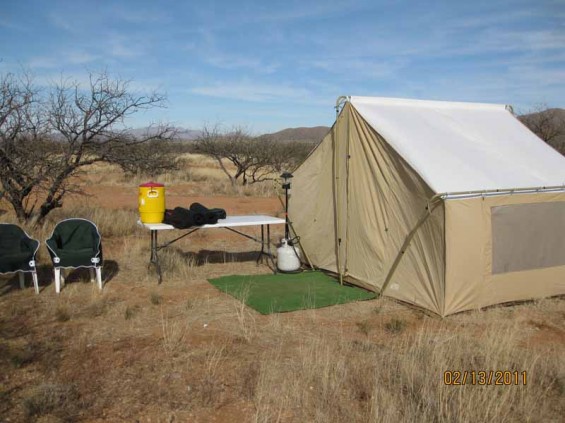
You may bring your own tents, trailers or RVs to camp in. If you need camping gear, contact Amanda
Tentative Camp Schedule
(you may show up at camp at anytime and leave whenever you need to, but please let Amanda know what day and time you plan to arrive and let her know when you leave)
Thursday, Feb 14th, 2013
check-in to camp in the afternoon, light dinner served in the evening
Hunter Safety Talk – sometime in the evening
Friday – Feb 15, 2013 –
Breakfast – 6 am to 7 am
Hunter Safety Talk – for those that missed this the night before
Morning hunt
Lunch – 11 am to 1 pm
Afternoon hunt
Dinner – 7:30-8:30 pm
Saturday – Feb 16, 2013
Breakfast – 6 am to 7 am
Morning hunt
Lunch – 11 am to 1 pm
Afternoon hunt
Dinner – 7:30-8:30 pm
Sunday – Feb 17, 2013
Breakfast – 6 am to 7 am
Morning hunt
Lunch – 11 am to 1 pm
Pack-up and head home or Afternoon hunt for those who wish to stay
What you need to bring:
Personal Items: clothing, toiletries, sunscreen, hats, gloves, etc. It will likely be freezing at night and the early mornings, so please bring warm clothes. A camera is nice for recording some memories. A flashlight or headlamp will be useful at camp and during the hunt. Good hiking boots are recommended. If you are a light sleeper, you may want to bring earplugs as there may be people who stay up later than others at camp. We will also have generators running at times.
Camping equipment – tent, sleeping bag, sleeping pad. If you need some camping equipment, please let Amanda know(amanda@coueswhitetail.com) and we will see if we can find some to loan you. You will probably want to bring an ice chest in case you get a javelina and want to transport the meat and hide home.
Hunting Equipment — backpack, hunting clothes (camo is best), a weapon and ammunition (handgun, archery or muzzleloaders only), knife, binoculars. If you have a tripod for glassing, you will want to bring that too. A range finder is very helpful also for judging distance of the animals for a shot. You should also bring a gamebag, some large ziplock bags, and a cooler to put the meat in. You may also want to bring a pair of small rubber gloves to wear while cleaning the animal.
A Positive Attitude!! It is important that everyone come with a positive attitude and an open mind, ready to learn. We also ask that everyone be respectful and helpful to everyone attending this camp. We expect 60-100 people at this camp and so we ask that you go out of your way to maintain good relations with everyone. We want everyone to have a great time and a little courtesy will go along way.
Photo of the Babaquivari Mountains.
Location of the camp:
We will be camping on the beautiful Buenos Aires Wildlife Refuge. For more information about the refuge, visit their website:http://www.fws.gov/southwest/refuges/arizona/buenosaires/
There are special rules that apply when hunting and camping on the refuge. Javelina hunting is allowed on the refuge, but you may not hunt quail or some other species. We will be hunting on both US Forest Service Land as well as the Refuge, so different rules apply depending on the agency that oversees the land.
Directions from Tucson, AZ: From Tucson….go south on I-19 and go (about 33 miles from I-10) to the Arivaca Junction Exit 48. At the stop sign on the off ramp take a right to the next stop sign and then take another right and take your first left on to Arivaca Road and head west to the town of Arivaca about 23 miles or so, drive through Arivaca and stay to the right as the road drops down slightly after you pass the store with the only gas pumps, then drive for about 8-9 miles and take a right on to the High Gate North dirt road (there is not a sign, but there are some green fence poles there at the turn). The High Gate North road is between mile markers 3 and 4 on the Arivaca-Sassabe road, closer to mile marker 3. The main camp will be at or near camp spot 38. There will be numerous camping spots around there so we can spread out.
You may also reach the camp by coming south on highway 286 from Three Points. Around mile marker 12, you will see the Arivaca-Sassabe road that heads east from 286. Turn there and the High Gate North dirt road (there is not a sign, but there are some green fence poles there at the turn) will be located on the north side between mile markers 3 and 4 (closer to 3). The main camp will be at or near camp spot 38. There will be numerous camping spots around there so we can spread out. (see map above for more details).
Fall 2011/Winter 2012 Coues Whitetail Buck Contest
CouesWhitetail.com will again be sponsoring a COUES BUCK CONTEST for the sixth year. The contest’s purpose is to garner interest in hunting Coues whitetail and this website, and to share our hunt successes and pleasures from chasing the gray ghost.
This contest will be open to registered forum members of CouesWhitetail.com and their immediate families living in the same home (i.e.- husband, wife, son, daughter, sister, brother). Deer must be taken legally from Arizona, New Mexico and/or Mexico during the August 2011-February 2012 seasons. If you have multiple tags, i.e. from different states or reservations, you may enter deer from each hunt.
Contest Categories (15):
- Youth (ages 10-17) – largest Coues buck
- Youth (ages 10-17) – smallest Coues buck
- Archery- Highest P&Y gross Typical frame Coues
- Archery- Highest P&Y gross Non-typical Coues
- AZ&NM rifle – highest gross B&C Typical frame Coues
- AZ&NM rifle – highest gross B&C Non-typical Coues
- Mexico rifle – highest gross B&C Typical frame Coues
- Mexico rifle – highest gross B&C Non-typical Coues
- Smallest Spike Coues buck
- Smallest 3×3 typical Coues Buck (not counting eye guards)
- Best Field Photo of Harvested Deer (aka “Hero/Trophy” Photo) – Based on composition & quality of photograph, not antler size. All contest photos will automatically be considered for this category. This post may help with the taking of your photo.
- Best Spirit-of-the-Hunt Photograph – Captures the spirit and moment of the hunt. These may include photos of packing, hiking, glassing, camp, scenery with hunters, etc. Photos may be taken while helping others on their Coues hunts. (Field photos of harvested deer excluded).
- Best Photo Essay of the Hunt – Best pictured story of the hunt with numerous quality photographs supported by a well-written story.
- Best Junior Hunt Story as written by the Junior Hunter
- General Drawing – those entrants not winning a prize in one of the categories will be in a drawing for prize.
Registration.
There is no pre-registration required, except that you must be a registered forum member before your hunt starts. Anyone who is a registered forum member BEFORE their hunt starts is automatically eligible to enter the contest. You must post your photo and hunt story to be entered in the contest, see below for more details on entering the contest.
Entry Fees & Prize Donations.
There is no fee required to enter the contest. You may wish to donate a piece of hunting equipment to the prize packages. Prize donations are not required, but are appreciated. You may also send a small financial donation to help with shipping or purchasing of the prizes. To donate financially, please send the money through PayPal on the CWT.com home page and note that it is for the contest. Please contact Doug/Red Rabbit if you wish to donate an equipment prize. Prizes awarded, and the number of contest places, will depend upon the number of prizes donated.
To enter your deer:
Post your picture and hunt story in the regular forums. If you have difficulty posting a picture, this thread may help, or asking another member will certainly get it done.
http://www.coueswhit…?showtopic=3721
Then, E-mail Doug/Red Rabbit the field photo of you and your deer, its gross B&C/P&Y score, and a link to the story you posted. Amanda and Doug will post pictures on the home page and in this contest thread. Click here to email Doug.
If you do not post a story, photo, and email the info to Doug/Red Rabbit, you will not be entered in the contest. If you just wish to share your hunt in the forums, but not enter the contest, then do not send Doug your link, photo and score.
Scoring your deer.
Amanda has a nice “how-to” on the home page complete with photos, instructions and downloadable score sheets. Again, the gross score is needed for this contest. Do not add any non-typical point lengths for the typical category. If the deer is a “spike”, submit just the lengths of the two spikes.
Entry photos with info/story must be posted in the forums and e-mail received by Doug/Red Rabbit by Feb. 15, 2012.
Hope all of you have a successful Coues season.
Current Prize list (this will be updated as we get more items)
Thank you to all those who have donated!! We really have some great prizes lined up this year!
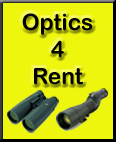
10 day rental of Swarovski Spotting Scope or 15×56 Bino and tripod, including shipping (retail value $240) donated by Optics4Rent.com.
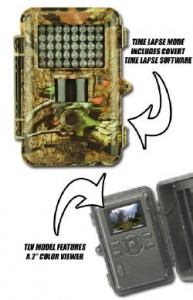
Covert Extreme Trail Camera (retail value $250) donated by CouesWhitetail.com.
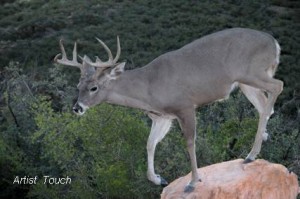
$300 off a Deer Shoulder mount or any taxidermy work done by Dan Lee at Artist Touch Taxidermy (this can be applied to any type of mount, not just a deer shoulder mount). There is no expiration date on this offer.
Guess the score contest – April 2011
Thanks to Augustin Ruiz of New Mexico for sharing this awesome buck with us for our contest. We had 187 people guess a score on this buck and the top 10 are listed in the table below. Many thanks to Matthew Young (aka JavaCowboy) for writing the code to grab the guesses out of the forum thread. Thank you Matthew, you help make this so much easier!
The top 10 people (highlighted below in the table) win a CouesWhitetail.com tshirt. Winners can pick a style, color, and size on the tshirt page. I may be out of some sizes/colors/styles, so email me your top two choices for a shirt. Please email me with your forum name, real name, and address so I can ship you your prize. Please email me rather than PM me as my inbox gets full too fast!
|
This buck was officially scored by a B&C measurer and here are the measurements:
|
||||||||||||||||||||||||||||||||||||||||||||||||||||||||||||||||||||||||||||||||||||||||||||||||||||||||||||||||||||||||||||||||||||||||||||||||||||||||||||||||||||||||||||||||||||||||||||||||||||||||||||||||||||||||||||||||||||||||||||||||||||||||||||||||||||||||||||||||||||||||||||||||||||||||||||||||||||||||||||||||||||||||||||||||||||||||||||||||||||||||||||||||||||||||||||||||||||||||||||||||
2010-11 Coues Buck Contest Winners
Congratulations to all our winners! And a big thank you to all those who contributed prizes to this contest. We had some outstanding prizes donated. Wild Heritage Taxidermy,Weller’s Wildlife Studio, and Artist’s Touch Taxidermy donated shoulder mounts. Jim White donated one of his outstanding tripod heads. Best Hardware donated an awesome Yeti cooler. Vortex donated a scope and a pair of binoculars. Sportsman’s Warehousedonated $175 worth of gift cards. There are just too many great prizes to list here. View a complete listing of prizes and who donated them.
Thank you very much to ALL who donated. We couldn’t have such a fun contest without you! Please remember to support those businesses that help support this website and this contest!
We will be mailing prizes out to the winners as soon as we can. If your address has changed recently, please email me to let me know, amanda@coueswhitetail.com
To see photos of the winners, click on the purple title of each category and it will take you to another page displaying those photos and a link to the hunt stories.
| Youth Largest (photos) | Score | Prize |
| 1st – Sadie Anderson, Sadiebug | 116 | Vortex Diamondback 12×50 Binoculars |
| 2nd – Jesse Haller, khaller | 98 6/8 | $50 Sportsman’s Warehouse gift card, camo cap by Phil Cramer |
| 3rd – Forrest Kelley, APatKelley | 87 2/8 | $25 Bass Pro Shops gift card, camo cap by Phil Cramer |
| Honorable Mention – Ashlen Kelley, apatkelley, | 81 4/8 | $25 Bass Pro Shops gift card, camo cap by Phil Cramer |
| Honorable Mention – Courtney Pinard , Cohofishing | 66 4/8 | $25 Sportsman’s Warehouse certificate, camo cap by Phil Cramer |
| Honorable Mention – Lauryn Villegas, tanclan4 | 63 2/8 | Never Enough DVD by Phil Cramer, camo cap by Phil Cramer |
| Honorable Mention – Vinni Pugliese, cpugsie | Vaportrails DVD by Northstar Video, camo cap by Phil Cramer, $25 Sportsman’s Warehouse gift card | |
| Honorable Mention – Cory Charter, firstcoueswas80 | Vaportrails DVD by Northstar Video, $25 Sportsman’s Warehouse gift card |
| Youth Smallest (photo) | Score | Prize |
| 1st – Matt Sipe | 1×1 3 4/8”+ 3 1/8” | Olympus 10-30×25 Binoculars by Cameraland |
| Archery Typical (photos) | Score | Prize |
| 1st – Weston, Weston Barkley | 117 1/8 | Wild Heritage Taxidermy Shoulder Mount |
| 2nd – Standman, Brian Fish | 108 1/8 | Winners Choice String by Bear Mountain |
| 3rd – Mike Ornoski, bowhunter4life | 97 4/8 | Rage KE40 Broadheads by Carl Pugliese |
| 4th – Jim Mullins, Coosefan | 90 | Arizona EZ Fletch by Archery Headquarters |
| Archery Non-Typical (photos) | Score | Prize |
| 1st – Josh Tod, Joshy25 | 100 5/8 | Yeti Cooler by Best Hardware |
| Rifle Typical (photos) | Score | Prize |
| 1st – Chris Woodley , 1archer | 119 2/8 | Vortex Diamondback 4-12×50 Riflescope,Outdoorsman’s Resource Guide |
| 2nd – Jay Williams, DiamondJ | 117 7/8 | Jim White Tripod Head, Outdoorsman’s Resource Guide |
| 3rd – Clinten Neff | 111 5/8 | Game Fresh System, Outdoorsman’s Resource Guide |
| Rifle Non-Typical (photos) | Score | Prize |
| 1st – Josh White jmwhitehunter | 128 1/8 | Covert Trail Cam, Outdoorsman’s Resource Guide |
| 2nd – John Garrett, NOFX | 101 5/8 | Kings Camo Outfit by Mullins Outfitters,Outdoorsman’s Resource Guide |
| Mexico Typical (photos) | Score | Prize |
| 1st – Josh Epperson, Grong | 111 5/8 | Wellers Wildlife Studio Shoulder Mount |
| 2nd – Phil Cramer, Cramerhunts | 108 4/8 | Dan Lee (Artist’s Touch Taxidermy) Shoulder Mount Discount |
| 3rd – Jeremy Gugelmeyer, JeremyKS | 107 6/8 | Custom Topo map by Gila Wilderness Hunting, $25Bass Pro Shops gift card |
| Mexico Non-Typical (photos) | Score | Prize |
| (no entries in this category this year) | ||
| Smallest Buck (photo) | Prize |
| Chris McFarland, Huntin4 | Browning’s Custom Meat Processing Discount by Jeremy Browning |
| Best Field Photograph (photos) | Prize |
| 1st – Jason Scott, Shortpants | Whitten Leather Gun Case |
| 2nd – Casey Charter, firstcouewas80, | Framed Coues Print by Mike Grootegoed |
| 3rd – Jim Mullins, coosefan, | Zeiss Knife |
| Spirit of the Hunt (photos) | Prize |
| 1st – Phil Cramer, Cramerhunts | Camo Duffel and Elk Pen donated by Tom Joiner |
| 2nd – Ryan Deadmon, Youngbuck | Havalon Knife |
| Best Photo Essay (links to essays shown below with names) | Prize |
| 1st – Hector Albarran, ChefHector’s Hunt Story | 10 Day Optics4Rent Rental, Round Valley Arms set |
| 2nd – Phil Cramer, Cramerhunts,Phil’s Hunt Story
|
$25 Bass Pro Shops gift card, Round Valley Arms set |
| Best Youth Hunt Story (link to essay shown below with name) | Prize |
| 1st – Sadie Anderson, SadiebugSadie’s Hunt Story
|
$25 Sportsman’s Warehouse Gift Certificate |
| 2nd – Matt SipeMatt’s Hunt Story
|
$25 Sportsman’s Warehouse Gift Certificate |
More CWD Found in White Sands Missile Range Deer
February 4, 2003
WHITE SANDS MISSILE RANGE, N.M. – Chronic Wasting Disease has been found in three more mule deer from White Sands Missile Range, the New Mexico Department of Game and Fish announced Tuesday, Feb. 4.
Presence of the disease, which is always fatal to deer or elk, was confirmed by Colorado State University in Fort Collins, Colo., said Kerry Mower, a wildlife disease specialist for the Department.
One positive animal was tested in December via a new tonsil biopsy technique that allows healthy deer to remain alive. After the positive result on the tonsil tissue, the animal, which was given a radio collar, was killed. Two positive animals were tested through routine collection during the fall. Examination of their brain stems discovered they were infected with CWD.
The first case of CWD in New Mexico was detected in a White Sands mule deer tested in June, 2002. The most recent Missile Range deer are the only positive animals found in 557 animals tested statewide since the fall hunting seasons began in September, Mower said. An additional 59 samples remain to be examined and Mower expects the state to collect as many as 100 more by the end of June, 2003.
“With an incubation period between 18 months and five years, the prevalence rate we are detecting at White Sands suggests CWD has been present there for a number of years,” Mower said.
Out of 15 White Sands deer tested, four were positive. Samples from seven deer killed during a January hunt in the Organ Mountains, adjacent to the Missile Range, are among the 59 samples that will be tested at CSU in the near future.
Chronic Wasting Disease is a transmissible spongiform encephalopathy, a family of diseases that includes bovine spongiform encephalopathy, often referred to as mad cow disease. Sheep experience a similar disease called scrapie and Creutzfeldt-Jakob Disease is one name for this type of disease when it occurs in humans. Transmissible spongiform encephalopathies are believed to be caused by prions (proteinaceous infectious particles) rather than bacterias or viruses. The prions cause gaps in brain tissue but samples must be preserved within 48 hours of an animal’s death for the disease to be detected.
Chronic weight loss is a classic symptom of Chronic Wasting Disease. Animals also might stumble, appear lethargic, salivate excessively or drink water excessively.
Mower said the State of New Mexico is uncertain how CWD may have been transferred to White Sands. It has been studied for three decades in northeastern Colorado and southeastern Wyoming, where it first was recognized. Since then it has been detected in either wild or captive-bred herds of deer or elk in Illinois, Kansas, Minnesota, Montana, Nebraska, Oklahoma, South Dakota and Wisconsin. It also has been found in the Canadian provinces of Alberta and Saskatchewan.
Mower said the State of New Mexico will continue to test deer on and near White Sands Missile Range in the future to help determine the extent of the CWD contamination. Mower is in Laramie, Wyo., this week at a meeting of states developing strategies for containing CWD.
There is no evidence that CWD can be contracted by humans, however, the New Mexico Department of Game and Fish has encouraged hunters handling dead deer to use some precautions. No nervous-system tissues – brains, spinal cords, lymph nodes, eyes – should be eaten. Hunters should use latex gloves while dressing animals.
Any deer killed in Big Game Management Unit 19, which includes White Sands Missile Range and the Organ Mountains, must be deboned before being removed from the mountains. Only skullcaps clean of any flesh were allowed off the mountains during the January hunt.
“We will continue to monitor this problem to the best of our ability and take every action we possibly can to protect the health of New Mexico citizens and wildlife,” said Larry Bell, director of the New Mexico Department of Game and Fish. “Although we appear to have a problem in the White Sands area, overall our testing indicates this disease is not widespread in the state.”
To prevent further contamination, Bell has declared an animal health emergency within New Mexico and is not allowing the importation of any cervids – deer or elk – at this time.
According to Brig. Gen. William Engel, commander of White Sands, the missile range will work closely with the state to define the problem and has offered its full support.
Rabies Information
Arizona Game and Fish Department
NEWS RELEASE
For immediate release Jan. 22, 2003
Campers, Hikers Encouraged to Take Precautions Against Rabies Exposure
(Phoenix, Ariz.) – After a record year of animal rabies and with warmer weather inviting more outdoor recreation opportunities, the Arizona Department of Health Services and the Arizona Game and Fish Department are encouraging Arizonans to take precautions to protect themselves and their pets from rabies exposure.
Last year, there were 143 cases of animal rabies, compared to 129 in 2001. Rabies infection was confirmed in 56 bats, 44 skunks, 33 foxes, three bobcats, three llamas, two coyotes, one dog and one javelina.
So far in 2003, three foxes and one skunk from Cochise County and a fox from Maricopa County have tested positive for rabies. There have been two human exposures attributed to the rabid fox in Maricopa County.
“People can be exposed to rabies when they attempt to approach, assist, feed or handle wild mammals,” says Craig Levy, Department of Health Services biologist. “And, many pets that are off-leash are exposed to rabies when chasing wild mammals. Keep your pets vaccinated and under control at all times. This serves to protect them and you.”
Though bats are the wildlife group most people associate with the virus, any mammal – particularly foxes and skunks – are potential carriers of this disease.
A javelina from the Globe area that tested positive for rabies in December is also a timely reminder for hunters to take precautions when handling game. “The hunting season for javelina started this month and one hunt or another will be open until early March,” says Randy Babb, an Arizona Game and Fish Department spokesman. “Hunters should always wear rubber or latex gloves when cleaning their animals to protect themselves from disease.”
Babb urges all outdoor enthusiasts to avoid contact with wildlife acting in an aggressive or abnormal manner, and to refrain from handling wildlife found dead in the field. “If you see a wild animal that is sick or acting strangely, report it immediately to Game and Fish Department officials, or to your local animal control office,” he says.
Rabies is a viral disease that attacks the central nervous system and is always fatal once symptoms appear. The virus can be transmitted to people or animals through bites from infected animals or exposure to infected saliva through open wounds or mucous membranes.
Individuals who are exposed to a rabid animal must promptly receive rabies vaccines and anti-rabies serum to prevent the disease.
Health Services and Game and Fish Department officials recommend the following to protect you and your pets from rabies:
- When enjoying outdoor activities, such as hiking or camping, avoid wild mammals, especially those that are behaving abnormally. Such behavior from the animal might include: showing no fear; unusual vocalizing; staggering and/or acting sickly; and nocturnal mammals that are active during the daytime.
- Do not pick up, touch or feed wild or unfamiliar mammals. If someone has been bitten or scratched, or has had contact with the animal, report it immediately to animal control or health officials and consult a physician as soon as possible.
- Campers should keep pets under control and maintain a clean camp to discourage visits from unwanted wildlife. Do not leave uneaten food out when you retire for the evening.
- Always contain and place trash in a location inaccessible to wildlife. Pet food should not be left out overnight.
- Keep pets on a leash and do not allow them to wander.
- Vaccinate all dogs and cats against rabies. Pet owners should check the vaccination records of any previously vaccinated animals to ensure that the animals are current in their vaccinations.
- Do not disturb roosting bats. If you find a bat on the ground, don’t touch it. If the bat is found in an urban area, report the bat and its location to your local animal control office or health department.
For more information about rabies, call your local health department, the ADHS Vector-Borne & Zoonotic Disease Section at (602) 230-5932 or the Arizona Game and Fish Department at (602) 942-3000.

